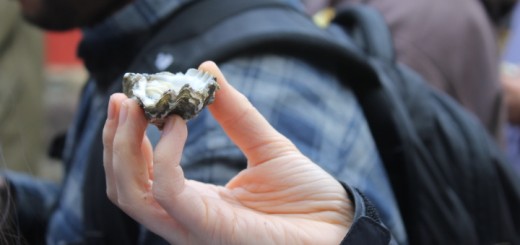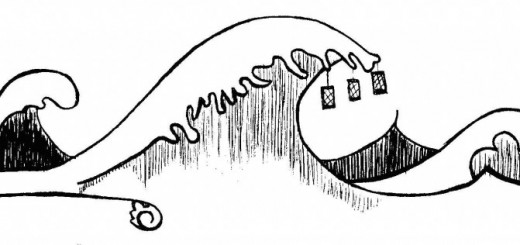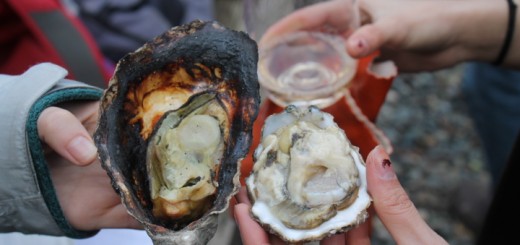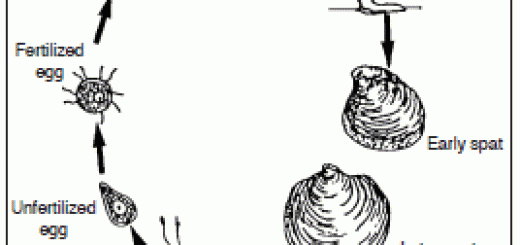Natural History of Oysters
The Pacific oyster (Crassostrea gigas) originally comes from Japan where it has a long history of cultivation. It’s prodigious acceptance around the world can be attributed to the relative ease of its cultivation, which result from its tolerance to environmental factors such as, water temperature, salinity levels, and pH levels. Such tolerance can be attributed to its huge success around the world, in which it is one of the most well known Oyster species. The Pacific oyster was introduced to the west coast of the U.S. around the 1920s in hopes that it could replace the depleted native oyster population which had been suffering from poor ecological service managements and even worse fishing practices. Due to its prodigious ability to feed and reproduce many environmental agencies in certain parts of the world view the Pacific oyster as an invasive species, where it outcompetes native populations of shellfish. Many scientists and researchers agree that in the state of Washington, the native Olympia oyster population stands a slim chance at rebounding from its dwindled numbers due to a number of factors, the presence of the Pacific oyster being one of them.
-Glenn Tippy (Edited by Nora Hantula & Lliam Carlton)

Larval development of Pacific Oysters http://www.fao.org/docrep/007/y5720e/y5720e0a.htm
Pacific oysters can be found in estuaries around the world. They thrive in intertidal zones of around 6-12 feet deep . They prefer a salinity of around 23-36 psu, but can tolerate a range of lower salinities as low as 10 psu. They can be found in waters ranging in temperature from 40-95°F. The can be found living in much colder waters but will not reproduce. For reproduction to occur the water needs to be around 70°F. pH plays a role in their life cycle, but not as much as temperature and salinity levels. Pacifics can be found in waters ranging from a pH of 5.5-9. In their larval stage they they have a foot which helps them swim in search of suitable waters and a sufficient substrate to attach to. Their prefered substrates are either rocks or other oyster shells. And once they find a suitable site that meets all of its criteria they attach to a substrate with their swimming foot, where they will remain for the duration of its life. Once attached to a substrate they are now considered spat. For waters to be suitable many factors can come into play such as, proper sunlight penetration/turbidity, and sedimentation around the substrate. In suitable and productive areas, given enough time, oyster reefs can begin to form.
-Glenn Tippy (Edited by Nora Hantula & Lliam Carlton)
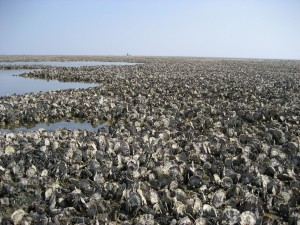
Photo of an oyster reef http://lms.seos-project.eu/learning_modules/marinepollution/marinepollution-c04-p10.html
Pacific oysters are protandrous hermaphrodites and typically start their lives off as males, but will change between male and female throughout their life cycle. Factors such as, age, water temperature, food availability, and salinity play a role in determining if the oyster will be either male or female. Pacific oysters can simultaneously begin to spawn when particle salinity units are around 20-30 and the temperature of the water is around 70°F. Eggs and sperm are fertilized externally in the water column. Females are known to release millions to hundreds of millions of eggs every year.
-Glenn Tippy (Edited by Nora Hantula & Lliam Carlton)
In the United states the most popular oysters by far are the Pacifics and Atlantics, two different species native to very different parts of the world. Crassotrea virginica lived in massive reefs made from each other stretching from the Gulf of the St. Lawrence, Canada all the way down to Brazil. Colonist made their way through the seemingly endless population of eastern oysters, simultaneously destroying their habitat with poor harvesting techniques and failure to assist their procreation. Industrialization also took a toll on the Atlantic oyster populations, they have had little chance to compete with rampant over fishing, but because of their undeniably important roll in the ecosystem and our diet they’ve been coming back in strong numbers marketed as the great Wellfleet oyster of the Cape. Cape Cod named for its common fish is know far and wide for its yellow sand beaches and seafood. On the Cape, the town of Wellfleet is known by name (and its popular oyster-shell logo) for its nearly perfect oyster habitat and delectable shellfish. Though cultivatable less than half of all Atlantics are aquaculture and they continue to be harvested from the wild, making up 70% of total oyster harvests. Atlantics are known for their cold temperature tolerance and their salinity range tolerance, optimally between 10-28 ppt with adults living comfortably in 35 ppt. The eastern oyster spawns only when the tides are warm enough (60-70 degrees f) from July to November meaning that in colder climates they may be more desirable during the summer months. In their natural habitat Crassotrea virginica’s large and densely populated reefs, which can host more than 1,416 oysters per square meter in higher inter-tidal ranges, break up water movement decreasing turbidity and creating habitat for small fish and invertebrates. These filter feeders also have been reported in lab settings to exchange 6.8 liters of water per hour, though up to 36 liters per hour have also been reported. Oysters are one of the most conceptually compelling and gastronomically enticing food sources available, mostly because they contribute to a cleaner, healthier environment and offer us a highly nutritious, arguably exotic, protein; this is why the oyster deserves every chance it gets.
-Lliam Carlton (Edited by Nora Hantula, Glenn Tippy)
It has been seen that many of the parasites that perpetrate the Crassostrea gigas result in worse results for the people eating them than the oysters themselves. However, parasites and pollutants that don’t shortly kill unsuspecting oyster consumers, are changing the taste dynamics of the shellfish. When an oyster is bad, the taste immediately knows it by the rotten aromas and sour taste. But when an oyster is bad, and not the type of bad that kills, the taste profiles begin to change and we lose the taste of the sea. Water pollutants that hover around oyster beds increase the amount of abnormalities in larvae development and kill off more spat before they have a chance to attach to calcite. Those that do survive suffer from the perspective of the taster because of a loss in salinity. Specifically, the Crassostrea gigas face a decline in salinity when introduced to toxins in their environments such as copper, S-metolachlor, and pesticides.
Oysters face a large array of life-challenging organisms from their solitary spaces inside unmoving calcite shell. Parasites infiltrate the inside of their shells and live in the body of the creature. Competitors take away nutrients by living in the same environment as the oysters. Predators use the oyster as their own personal sustenance, breaking open the shells and sucking out the muscle hiding within. Typically, the parasites that attack oysters kill them while they are still unprotected spat, or prior to spat-hood when the larvae is just forming. A herpes-like virus is found in all types of oyster, not just Crassostrea gigas, as damages the structural build of tissues and cells. In many oyster beds, viral purifications have been taking place to further prevent the parasite from spreading. Competitors that live around oyster beds will leave less nutrients for oysters causing the bodies of the oyster to grow slower over and stay at a less than average size. Predators of the oyster include birds, fish, and humans. Most extreme, the starfish is the oysters most dramatic predator (maybe second most to the human which is naturally dramatic itself). Shellfish grab onto the oysters hinge, or at where the shells meet, and launch their stomachs into the shell of the oyster to break it and suck out the flesh.
-Nora Hantula (Edited by Glenn, Lliam Carlton)

